IMPACT OF LIBERALIZATION ON THE INSURANCE SECTOR IN INDIA
This study identifies the impact of liberalization on the insurance industry in India and particularly on LIC. Efforts have been invested, starting from problem formulation to overall impact measurement. After assessing the conceptual foundations and conducting an empirical testing of the present state of the insurance sector in India, conclusions point towards eighth dimensions of impact measurement. These eight dimensions are: service quality, perceived values, purchase intentions, repurchase intentions, market dynamics, exception handling, satisfaction and dissatisfaction on which the impact of liberalization can be measured. Finally, these eight dimensions taken for impact measurement are summed up into four measurements. The four measurements are sources of competence, behavioural intentions, contemporary dynamics and overall satisfaction. All the dimensions are statistically proved and having values on or above the acceptable limit. In other words it can be said that, the impact of liberalization has come in terms of these four variables.
INTRODUCTION
The history of insurance is rooted within the story of mankind. The same instinct that stimulate modern businessmen and gives them a sense of security against loss and disaster also existed in primitive men . Primitive men also sought to avert the evil consequences of fire, flood and loss of life and were willing to make some sort of sacrifice in order to achieve security. The concept of insurance has moved through various situations and phases in its journey. With the passage of time many elements have been preserved or discarded, largely being a conceptualization from the recent past.
Insurance is the most effective way of strengthening and hedging the risk. Since its appearance, insurance has become an inevitable asset to every aspect related to human life. Whether it is health disorders or constructing properties, household requirements or multimillion dollar projects; insurance is being recognized as a strong safety device to meet unexpected losses. It is clear that generally, an insurance firm tolerates the liability of offering world-class services to their clients, which requires efforts in each aspect. The insurance business in India started without any obligations in the nineteenth century. At that time, it was a typical story of a colonial era. Only few British insurance companies were controlling the whole market and were serving the larger cities of India. The Life Insurance Company was domestically floated in 1956 after independence, and then the firms were formed in 1972 in the general insurance business. Till the entry of private firms, the Life Insurance sector in underdeveloped markets was only tapped by LIC of India (the only public sector life insurer).
The dispersion of life insurance products and services extended to 19% of the total 400 million of the insurable population. The insurance products sold by the state owned LIC were mostly tax saving tools. Insured customers had almost no flexibility in availing the products. With the entry of private firms the rules of the scenario have changed. The Government of India liberalized the insurance sector in March 2000 through the Insurance Regulatory and Development Authority (IRDA) Bill, lifting all entry decisions for private firms and allowing foreign firms to enter the market with some restrictions on direct ownership. The bill was passed to guard the interest of the customers in their dealing with global and private firms. Under the present guidelines, there is a 49% equity cap for global
investments in an insurance company. Taking all facts into consideration, it is true that the LIC of India is still dominating the industry and is the consistent market leader in the insurance sector of India.
THE LITERATURE REVIEW
A literature review is conducted to generate a theoretical and scientific analysis of a particular phenomenon and uncover what is known and the gaps related to that topic. The primary purpose of a literature review is to gain a broad background related to problems in conducting research on a particular topic, selecting a problem and purpose, developing a framework and formulating a lesson plan. In order to attempt reach this goal, an attempt has been made to review and discuss literature related to the field of insurance.
Available Literature Before 1990
Dodds J.C. and Croom H. (1979) have critically analyzed the investment behavior of life insurance companies; with an objective to providing guidelines to show the future investment pattern in the insurance business. Hubner S.S. and Kenneth B. Jr. (1982) have worked on life insurance & health insurance and the different types of products and plans that are offered by insurers. The fundamentals of pricing of a variety of products, the organizational and marketing aspects of insurance firms are also discussed at length by the authors.
Marks,S. D. (1982) explained the fundamentals of insurance and discussed the various types of insurance such as life, fire, marine, life etc are discussed in detail.
Rajan Sexena (1986) in his article titled “Marketing of Life Insurance Services”, discussed different issues related to the marketing strategies of insurance firms. The author focused on the importance of applicability of marketing concepts to the selling of life insurance products, and the need for interactive strategies in the marketing of life insurance products.
Available Literature between 1990- 2000
Hofsted G. (1995) identified the major function of life insurance was to guard against financial loss. Any event affecting an individual’s earning ability has an impact on the individual’s human life. This event may be
early death, incapacity, retirement or unemployment. Besides covering the risk of death, it covers the risks of disability, serious illness and superannuation.
Pedro P. B. (1996) in his article “Competition Effects of Price Liberalization in Insurance” outlines the insurer’s decision making process, and their exercise of monopoly power. The author concluded with presenting a case study of the Portuguese auto-insurance market. Two distinct time spans were taken and a panel of data was used. 1982-1988 was characterized by price regulation, and 1989-1990, was characterized by pricing freedom. A clear change in the company’s market conduct was observed after the price liberalization event. The results suggested that firms behaved in a more competitive way than the post liberalization period, where a significant degree of conspiracy was identified.
Gidhagen (1998) attempted to develop a conceptual framework from a relationship perspective for the study of insurance services marketing. Deregulation and internationalization have created a new, increasingly
competitive business climate. The focus of this research work is on the relationship between insurance companies and their corporate customers.
Mishra and Simita M. (2000) compared the position of the Indian insurance sector to European countries, in which life insurance accounted for 58% of the global direct premium and non-life comprised 42%. The study states that the need for insurance arises when economic activity increases, families become nuclear, kins gets geographically dispersed and individuals become more dependent on employment. The author analyzed the top ten largest insurance markets and how they are ranked by revenue in the year 1998.
Available Literature 2001 Onwards
Agarwal (2001) examined the role of information technology in the insurance sector in his study, and focused upon the requirements of providing effective services due to the entry of private firms. An insurance firm can utilize its services in many ways such as: customer service, investment management, claim management, relationship management etc. This article emphasizes that to gain overall boost in the size and revenue of the insurance market, it is understood that information technology must take on a vital role, to enable extensive penetration.
Michael (2001) analyzed the demographic facets in this article and appraised the insurance business with a case. Additional features added to conventional products are referred to as help products. In this study, the author has conducted a customer survey to identify the demographic aspects and their roles. The author has also invested efforts to analyze the consumer’s decision towards a new class of insurance products. Finally the study concludes that, there is a weak relationship between the consumer’s decision making process and the class of products offered, as demographic factors do not always perform as expected. Therefore, it seems sensible to focus on alternate factors alongside to ensure effective marketing.
Nikhil G. (2001) in his article has identified, that the strategies that Indian insurance firms adopt, is hinged upon the product’s essential usefulness in providing safety features. The author highlights the growing proportional aspects, penetration levels and other macro factors affecting the global insurance market during the year 1999. Each private player’s viewpoint is to sell the product for customers at their own risk.
Vasanthi S., Prakash, and Sithramu (2001) explored the (agents in the liberalized economy and the changes taking place in their management. This article aimed upon identifying the competencies needed and methodology
adopted for selecting effective agents. A sample of 15 agents of the age range between 28 to 47 years, and customers of such agents were taken for qualitative assessment. The findings of the research conducted indicated that, professional competency plays a vital role for successful insurance agents. The study also highlighted how to manage agents to develop competencies and area experts in the selection of effective agents.
Ajay K. R. and Mukesh D. (2002) focused upon the social implications in opening up of the insurance sector to private firms to identify reasons as to why there was private entry after nationalization, what the social aspects are so far and how the reforms have taken place in the Indian insurance industry. The issues faced by private firms due to competition are to enhance resource optimization, reduce premium cost, mobilize funds domestically, offer better pay packages and attract inflow of foreign capital. This study has also revealed that, most of the private firms concentrate on business only in the urban areas, due to a lucrative market response.
Pradeep G. and Sanjay B. (2002) analyzed and discussed the challenges with possible solution strategies, applicable to the insurance sector in India. Authors have made an attempt to identify how different brands can be positioned in the market and how business practice codes are given by IRDA to maintain standards. The research piece revealed that after liberalization, awareness of brands is 100% for LIC, 70% for ICICI Prudential awareness and 52% for HDFC.
Hendel and Lizzeri (2003) studied the long -term contract properties and found empirical support, for forecasting the model by using data from the life insurance market. In particular, they presented that all types of life insurance contracts especially the more front-loaded contracts, are associated with lower lapses and lower present discounted value of premiums over their coverage period. They argued that asymmetric information among others is not a reasonable option or explanation of their findings.
Pramod P. and Saumya S. (2003) in their research article tried to find out the competitiveness between LIC and the new players and carried out as SWOT analysis to advise effective strategies. The objective of this article was to assist the public sector insurance giant to boost the market share, to help LIC to retain old customers, and to attract new customers.
The study also highlighted the level of customer satisfaction and quality of services disbursed. The methodology applied in this article has been derived through open-ended interview with customers, to identify their perceptions and expectations. 100 customers in Dhanabad and its surrounding areas were selected to collect information on the sum assured, annual premium paid etc. The findings of the study noted, that majority of customers were graduates, who felt that the main work of LIC is to insure human life. Most respondents however preferred only money back polices and Bima Nivesh covering a single premium.
Hitt and Croson (2004) pointed out, that there were three principal issues i.e. transparency, dis-intermediation and differential pricing that help in determining the transformation of retails financial services, including
life insurance firms. The authors have explored, that financial services industries are gradually transformed by these three trends.
Vaidyanathan R. (2007) discussed regulation and financial convergence in the insurance sector. In his article he mentioned, that there is no legislative framework for considering the compound nature of the working of the financial corporation. A new structure needs to be developed to monitor activities of insurance providers in a structured system.
Santosh D. and Upinder D. (2007) tried to focus on global state of affairs, as they opine that India cannot remain inaccessible. It is apparent that the existing firms need to gear up to face the competition. These new firms will have to consider new requirements of customers. The existing firms will also have to take care of customer specific aspects and needs. As a matter of information, custom-based products will have to be developed to suit specific customer needs. New products have to be developed for large corporate groups. The Insurance industry is going to undergo a vast change in its marketing practices, as well as its marketing strategies. The existing and new firms will have to work out different strategies to keep and improve their market share.
Devasenathipathi, Saleendran and Shanmugasundaram (2007) in their study, “A Study on Consumer Preference and Comparative Analysis of All Life Insurance Companies” analyzed and rated all life insurance firms by analyzing certain factors. They examined the effect of privatization, measured customer perception, purchase behavior and consumer awareness regarding life insurance products. The study concluded that the deciding factor of the purchase process depended on quality, convenience and promptness of services that may lead a company to acquire the top
rank with a huge market share.
Pillai (2007) in his article titled the “Life Insurance Business” defined life insurance as, the business of offering contracts of insurance upon human life, including any contract whereby the payment money is assured on
death (except death by accident only) or the happening of any contingency affecting human life. This also includes any contract which is subject to the payment of premium for ensuring a team’s human life.
Narayanan (2008) in his article attempted to decode the secrecy of pension plans and assist people to zeroing down on an apt pension plan. Originally, it dealt with the basics of Unit Linked Pension Plans (ULPP) and how it works. The article explained how it is different from the traditional insurance plan and discussed, the basis for selecting an appropriate ULPP will would prove to be beneficial at the time of retirement.
Mahesh Chand G. and Deepti (2008) in their article, “Efficiency of the General Insurance Industry in India in the Post-Liberalization Era: A Data Envelopment Approach”, attempted to examine the technical competence
and the scale efficiency of 12 general firms in India , in the financial year 2002-03 and 2005-06. Their study presented that, private firms are lagging behind public firms but they are fast catching up and the competence
scores of public and private firms seem to converge.
James P.C. (2008) understood that by calculating the probabilities of the occurrence of risks leading to loss; it is possible to convert risk conditions into catalysts for driving the economic momentum in society. In fact insurance public good; regulation, self-regulations and standards usually requires that rates and terms are fair, reasonable and not excessive’
Ramin Cooper M. and Chris Sakellariou (2008) in their paper, “Financial Liberalization, Deposit Insurance and Bank Stability” investigated the impact of implementing an explicit deposit insurance scheme, on the likelihood of banking crisis in countries with well-liberalized financial systems. They concluded that deposit insurance will be successful in alleviating moral hazard and will increase the constancy of the financial system, only if an adequate degree of financial liberalization exists.
Sonia S.(2008) observed the potential for insurance companies in housing areas, with the objective to find out the profiles of consumers in insurance, and the attributes of insurance that become functional while taking decisions. The author concluded with findings from 500 respondents, that there is an immense prospect for insurance in housing areas as most of these areas are untouched. For insurance firms to be successful in their areas, must design their products and services in such a way so as to attract customers, and provide them with the best products and services.
Kirti D. (2009) focused on consumer beliefs and attitudes towards advertising media. He concluded that it is very important for marketers to generate advertisements that are believable and offer relevant information about the product. The message in the advertisements should focus on benefits and attributes, with required amount of creativity in it to get maximum results.
Rajendran R. and Natarajan B. (2009) highlighted that the business in India, the business outside India as well as the total business of LIC has always had an increasing trend. The collected and analyzed data proved that liberalization, privatization and globalization are exerting a positive influence on LIC and its performance.
Murthy T.N., Raja Babuand Riswana Ansari (2009) in the paper titled , “Performance Evaluation of LIC: Ways of Winning Confidence” highlighted the development and expansion of the company, a performance review before and after liberalization, their innovative product lines, improved customer services and enhanced distribution channels of Life Insurance Corporation of India (LIC). Their objectives was to know about the growth and development of the LIC business before and after liberalization, privatization and globalization; and to study the ways to improve
customer services in LIC for winning confidence, and making appropriate suggestions for the improvement of the LIC business. The study concluded that to achieve greater insurance penetration, public as well as private
insurance units have to improve in terms of quality of services offered and greater efficiency.
M.C. Garg and Anju Verma (2010) in their paper titled “An Empirical Analysis of Marketing Mix in the Life Insurance Industry in India”, analyzed the marketing mix in life insurance in India. The population for
this research comprised of all employees of public and private life insurance companies in India. A sample of 95 employees was drawn on the basis of convenient sampling. Their prime objective was to study the nature,
pattern and process of the marketing mix in life insurance companies in India. They concluded that various dimensions of the marketing mix where measured and analysed. For instance age-wise, sex-wise, qualification-wise, hierarchy-wise and organization-wise analyses depicted that a majority of respondents are of the opinion, that the concept of marketing mix is understood and implemented regularly, that the suppleness of various mix ingredients aren’t always studied by the marketing departments of life insurance firms, that the marketing departments of life insurance firms always review the mix, that regular careful analysis is carried out to develop an optimal and most economic mix, and that other departments are always invited to take part in developing this optimal mix . However,
they were also of the opinion that the marketing departments sometimes an attempt at quantifying the level of expenditure, that life insurance companies sometimes attempt at analyzing their competitors’ mix, and that life
insurance companies sometimes do briefing about the mix plan to outside contractors. Life insurance companies rarely adjust their marketing mix in relation to specific segments.
Manjit Singh and Rohit K. (2011 in their paper “Efficiency Analysis of the Public Sector General Insurance Companies: A Comparative Study of Pre- and Post-Reform Period”, compared the competence of the Indian
public sector general insurance firms during the pre- and post-reform periods. The pre-reform time span includes 1993-94 to 1999-00, and the postreform time span includes 2000-01 and 2007-08. The results concluded that the competence of the public sector general insurance firms is higher in the post-reform period, than the pre-reform period.
Debabrata Das and Jasojit Debnath (2012) in their paper, “Performance of Insurance Companies in India: A Comparison of Public and Private Insurers”, highlighted the performance of life insurance sector in terms of variety of parameters, and also threw light on the different marketing channels. Their study also suggested that life insurers have improved over the years, and insurance is now not limited only to a particular class or society. Rather with innovative products and better customer services, the insurance firms are trying to cultivate a insurance habit among
all segments of the population.
Pamecha and Chhajer (2013) in their article discussed the paradigm changes that took place in the Life Insurance industry in India. These authors have elaborated the rationale behind the leadership position enjoyed by LIC in the market. The recent regulatory changes in the Life Insurance industry in India have also been highlighted in the article. Authors found that the global integration of financial markets resulted from de-regulating measures, explosion of technological information and financial innovation. Also the study emphasized, that liberalization and globalization have allowed the entry of foreign players in the insurance sector, providing a better array of services for the customers at competitive prices.
V. Ushakiran, Maschendar and Sreenivasa (2013) discussed that growth in the life insurance sector touched new statures, and the entry of the private companies has given a tough challenge to the Life Insurance Corporation of India. The entire risk business has started to show significant changes. Right from increasing insurance penetration to changing the customer’s mind-set about life insurance to the state of reducing risk as an investment alternative. Insurance firms have started focusing upon innovative policies and creative practices in the Indian market. This orientation has changed the entire shape of the life insurance sector in India. Mandeep K. and Dalwinder K. (2014), in their paper, “Customer Satisfaction towards Life Insurance in Punjab” identified the association between
customer satisfaction and demographics of customers. Their study brought out seven factors through factor analysis, namely; services and company reputation, quick and timely services, customer convenience, additional facilities, loyalty of employees, efficient departments with disdisciplined employees, and service material and understanding of requirements.
Ramamoorthi and Kumar (2014), reviewed the theoretical analysis of product liability insurance between buyers and sellers. A model consisting of three groups of buyers, a producer-seller, and an insurance institution has been developed under varying assumptions in their study. Authors have found that the liberalization of the economy has resulted in the availability of large number of lucrative alternative products and financial services. Sinha (2015) has used a dynamic slacks based data development analysis model (DEA). The DEA model was proposed by Tone and Tsutsui (2010) to be used for performance evaluation. The same has been used in this study using 15 life insurance companies in a seven-year period (2005–2006 to 2011–2012). The author has identified that, the unique selling
point of the present approach is unlike the conventional static DEA models. He has also presented a framework, by using a link variable, connecting the observed years and thereby creating a common benchmark.
Joy and Pratim (2016) explored that in the pre-reform era, the Life Insurance Corporation of India dominated the Indian life insurance market with a market share close to 100 %. But the situation drastically changed since the enactment of the IRDA Act in 1999. At the end of the FY 2012-13 the market share of LIC stood at around 73%, with the number of players in India’s life insurance sector. The authors deliberated that; the reason for the decreased market share over this period could be attributed to the increasing competition prevailing in the country’s life insurance sector. At the same time, the liberalization of the life insurance sector for private participation has eventually raised issues, about ensuring sound financial performance and solvency of the life insurance companies; besides safeguarding the interests of the policyholders.
Kumar (2016) explored, that there has been an observable change in the market dynamics since liberalization and introduction of economic reforms. A considerable amount needs to be done for future growth and development of the market in an orderly and sustained manner. Even post liberalization insurance companies in India have been ignoring rural markets. Insurance companies in India will have to show long term commitment to the rural sector as well, and will have to design products which are suitable for rural people. Insurance companies need to think about their distribution mechanism to work effectively in rural markets.
Table 1: Identifications of Dimension from the Previous Literature
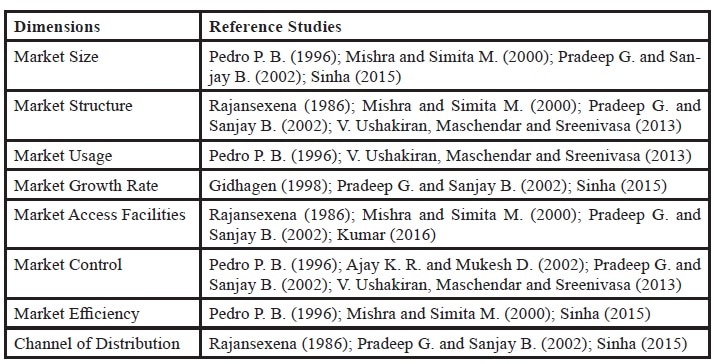
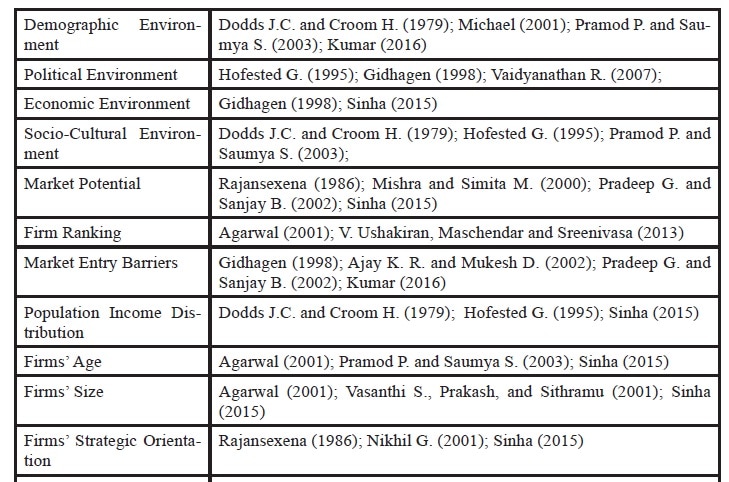
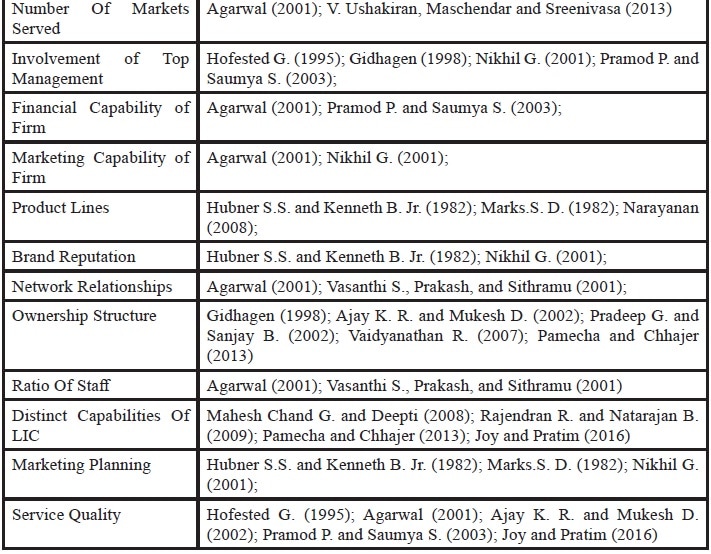
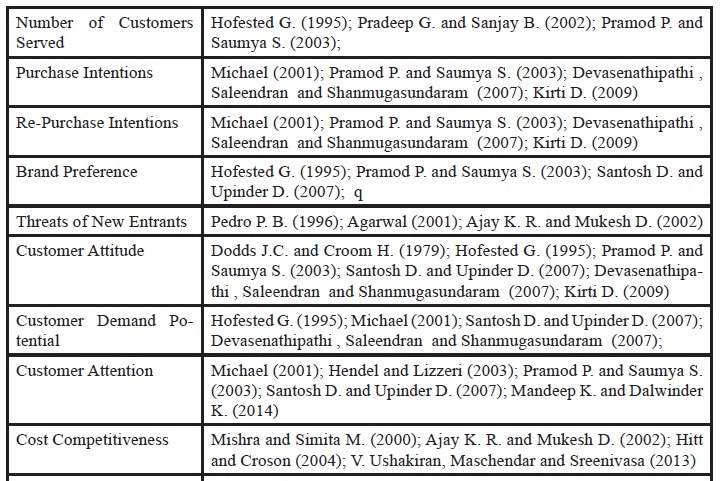
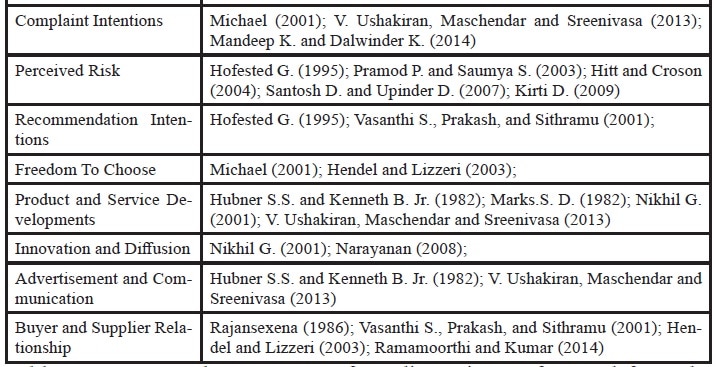
Observations from Conducting the Literature Review:
Observation 1. Previous authors have focused more on the operational efficiency andanalysis of the industry regarding insurance companies in India. The intention is more tilted towards policy formation and business
analysis.
Observation 2: Previous studies in this field are looking at the impact of liberalization on specific aspects. For example, policy holders, number of customers, number of companies, and total business of the insurance
sector in India etc. In general, the overall impact of liberalization on the insurance sector and LIC, is seeking the attention of researchers and so it will be rational to explore the same. The present study will act as bridge to address multiple dimensions under one umbrella, such as industry aspects, LIC related aspects and customer related aspects.
Articulation of Impact Measurement Variables
The Life Insurance market in India is an emerging market because the ratio of GDP to life insurance premium is only about 4 % and the dispersion level is about 26%. Though the market has grown exponentially following
liberalization with the entry of private firms on 1 April 2000, it is still an emerging market. Therefore, resourceful marketing strategies are needed by the insurance service providers for both these reasons. Firstly, to attract
new customers; and secondly to retain existing customers and increase market share. Research by Fornell (1992) , Lenskold (2003) and Lombardi (2005) has shown that, self-protective approaches directed at retaining existing customers and increased sales to them, can be more profitable than attracting new customers The objective of this empirical section is to identify the relationship between different aspects and factors related to the insurance sector, insurance business firms and insurance customers. Service Quality In the previous researches conducted on life insurance services, the service quality has been analyzed through consumer ratings of performance and observations of an agent, by using an adapted SERVQUAL or SERVPERF scale. This includes items from the original five factors but adapted, both in wording and context as opined by Tsoukatos and Rand, (2006). Durvasula et al. (2004) measured consumer service quality observations by calculating the compound score for each respondent from their ratings on a six-item scale; consisting of attributes related to sales agent quality of reliability, helpfulness, responsiveness, empathy, trustworthiness and product information. Studies have been performed taking financial products in India as a sample. Chaudhary (2013), Srivastava and Singh (2015) have identified and examined the importance of service quality in selling financial products in India.
Perceived Value
Perceived customer value is defined as the difference between total benefits and total sacrifices perceived by consumers in purchasing a product or service. Total benefits include the functional, social and psychological benefits as perceived by Sweeney and Soutar (2001), and total costs include the monetary costs emphasises by Monroe,(1990) and non-monetary costs state Anderson and Sullivan, (1993), namely energy, time and effort propounded by Cronin et al. (1997). The way customers perceive financial products, help financial and insurance firms to ensure customer satisfaction and competitive advantage state Zameer et al. (2015) and Mende et al. (2015).
Purchase intentions
According to Zeithaml et al. (1996), purchase intentions are “pointers”, which signal whether consumers will continue giving business to the firm. Models used in this study are founded on the learning theory, and accept that behaviour towards a particular object can be approximated by an intention to perform that behaviour , stated Cronin et al. (2000); Fishbein and Ajzen, (1975); and Mittal et al. (1999). Favourable behaviour contained of saying positive things about the company to others; recommending the company or service to others; paying a price premium to the company, and remaining loyal to the company. Unfavourable behaviours are demonstrated by customers displaying higher probability of brand switching; planning to reduce their capacity of business; engaging in negative word of mouth, and displaying unwillingness to pay premium prices,.Zeithaml (1988). Chaudhary (2013) have identified a relationship between service quality and purchase intention applicable to financial products. Although most research on experiences of purchase intentions have focused on either favourable or unfavourable intentions. Intention to complain in case of poor service has been included as an outcome variable in this paper, along with repurchase and recommendation intentions, which are construed as dimensions of customer loyaltyby (Cronin et al. (2000) and Durvasula et al. (2004). Most studies conceptualize and operationalize loyalty as consisting of two dimensions, i.e. attitudinal or willingness to recommend the product or service to others, and behavioural repurchase intentions; state Baumann et al. (2007) and Durvasula et al. (2004), and the two dimensions should be measured separately. Most research in marketing construes loyalty as multidimensional, though agreement on whether it has two or three dimensions is lacking as per Jones and Taylor (2007).
This paper conceptualizes loyalty as a two-dimensional construct of customer repurchase and recommendation intentions. Previous literature by Ferdous and Polonsky (2013) and Souiden and Jabeur ( 2015) establishes
a strong bond between ethical values, customer’s attitude, belief planned behavior and purchase intention).
Repurchase Intentions
Repurchase intentions are well-defined as “the individual’s judgment about buying again a designated service from the same company, taking into account his or her current situation and likely circumstances” state
Hellier et al. (2003, p. 1764). Word of mouth communication is defined as “informal communication directed at other consumers about the ownership, usage, or characteristics of particular goods and services and/or their
sellers” observed Westbrook (1987, p. 261).
Dissatisfied post purchase consumers are likely to engage in negative word of mouth, exit, complain to the offending firm, appeal to a third party, or to not make repeat purchases. Research by Tax et al.(1998) is focused on intention to complain to the firm, as this behaviour provides the firm with the opportunity to analyze and rectify the problem . Studies by Rahman et al (2014) have identified factors leading to repurchase intention for insurance products. Literature by Ramamoorthi et al. (2016). Showed, that service quality is the most prominent factor that motivates customers to repurchase insurance products.
Market Dynamics
The market environment determines the position of customers in the quantitative and qualitative aspect of the market state Salai et al. (2011). With the changing market environment, understanding the mode of entry or
ownership structure plays a significant role in adapting to changes. Research and innovation help to understand changing customer requirements and wants. Market control and relationships between networking markets,
determine the ability of a firm to control prices and achieve specified benefits.
Exception Handling
In top management views and prior research studies, financial capability of the firms and prior experience gained by the number of global markets served (taken from the firm oriented aspects) help international marketing
executives to handle these sort of situations and exceptions. However, the advantages and disadvantages of a particular situation vary considerably with the individual company’s financial situation. Liquidity and experience
affect the costs and benefits associated with each position in international markets, and thus its desirability to the company. Each company must therefore evaluate independently, the desirability of each position and select the most appropriate degree of international orientation in light of its own internal situation and objectives.
Satisfaction
Satisfaction is defined and measured as the disconfirmation or confirmation of consumer expectations by authors such as Bearden and Oliver (1985) and Cornwell et al. (1991). If the product exceeds or meets expectations,
a customer experiences satisfaction. Satisfaction is not only limited to service quality or brand of the company, but other attributes also such as demographics state Neelufar et al. (2015).
Dissatisfaction
When the company fails to meet the expectations of customers, it causes dissatisfaction as per East, (1997) and Stewart (1998). These expectations are determined by factors, such as advertising, prior experience, personal
needs, word of mouth and the image of the service provider opined Michel (2001). Dissatisfaction can lead to consumer complaint actions observed Singh and Widing (1991); East (1997); Heung and Lam( 2003) and Volkov
et al. (2002). Consumers will not initiate complaint actions if they are satisfied. Consumers can take various types of complaint actions, such as complaining verbally either directly or indirectly, writing complaints directly to the seller, or complaining directly to third parties (e.g. consumer councils or the mass media). The complaining customer is likely to defect as the last resort after his complaint has failed state Kim et al. (2003); and Colgate and Hedge (2001), while he is likely to stay if the complaint is resolved. Thus, resolution or response to consumer complaint action is
likely to increase customer loyalty. However Sogunro and Abiola (2014) say, that policyholders are not satisfied that life insurance products, should be based on these attributes
PROCESS METHODOLOGY
This was an exploratory study. Two different structured questionnaires were used for data collection. The first questionnaire is used to identify the exploratory variables. Questions in the initial part of this questionnaire
allowed respondents to develop a frame of reference and answer the questions with respect to the selected service provider. The second questionnaire is used to check the role and merit of impact measurement variables. Same respondents were selected from a list of customers, agents and development officers from the state of Haryana, which were available with LIC India for both the questionnaires. Respondents were selected based on the criteria that they had sold or purchased (policyholders as purchaser; agents and development as seller) a least one life insurance product (endowment policy, term policy or unit-linked insurance policy) in the previous six months.
The variables selected for the study were based on literature review. Data were collected by a questionnaire schedule through personal interview and discussion. The survey was conducted in Haryana at Panchkula, Ambala, Kurukshetra, Karnal, Panipat and Rohtak. Respondents were contacted by telephone for an appointment and then interviewed at their residence or place of work. A draft questionnaire was initially developed and pilot-tested with a sample of customers, to check for any ambiguities and communication errors. Field tests on the revised questionnaire were then conducted with a small sample.550 questionnaires were filled up by respondents through personal interviews. Responses were recorded and then measured on a five-point Likert scale.
Hypothesis for Empirical Analysis
H0 : There is no change in the attitude of the general public towards the concept of life insurance.
Perception: Customer attitude can be measured through perceived value and customer satisfaction.
H0: There is no change in the working module of LIC after the liberalization of the insurance sector.
Perception: Is there any change in Infrastructure, service quality and innovation, quality of sales agents?
The survey includes three categories of respondents:
1. Current policyholders of life insurance service providers in India (consisting of 400 respondents).
2. Agents (consisting of 100 respondents)
3. Development Officer (consisting of 50 respondents)
4. Results and Interpretation
The data collected was subjected to descriptive statistical analysis. This broadly consisted of the measures of central tendency and dispersion as shown in Table 2.
Table 2: Descriptive Statistical Analyses (N = 550)

This happens when results are compared with the bell curve for an ideal normal distribution. It reinforces the fact that this data is enabling for other statistical analysis methods. This also validates the method employed to
collect primary data and the items of the instrument.
Factor Analysis Statistics
The data of 550 respondents were subjected to Factor Analysis. After Varimax rotation, the factors emerged with Eigen values greater than 1.0, accounting for the independent decision variables and explaining 64% of the total variance as shown in Table 3.
Table 3: Factor Analysis on Initial Items
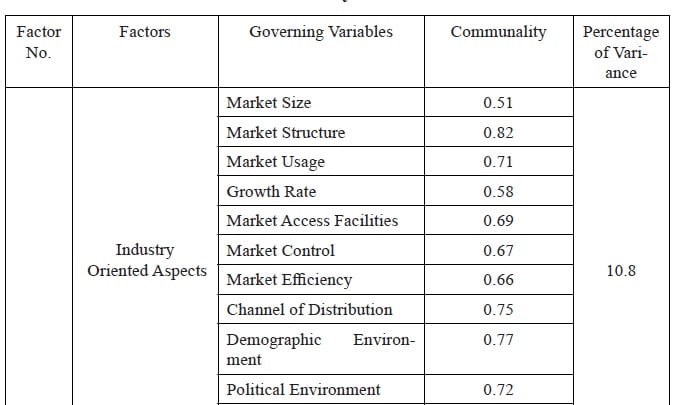
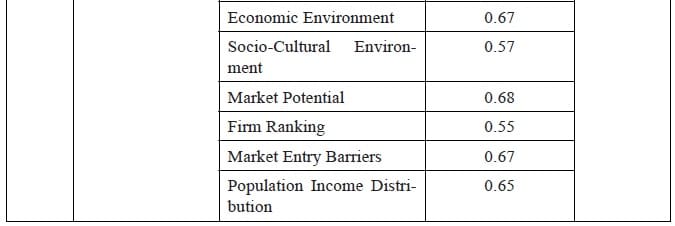
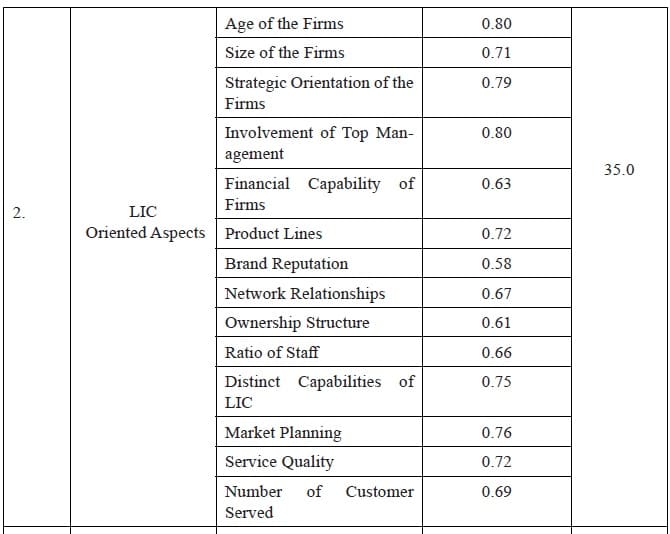
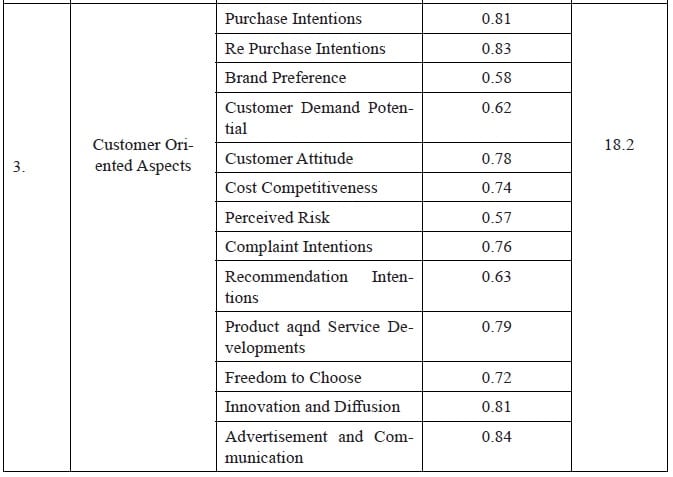
A total 48 variables were identified and were subjected to exploratory factor analysis (EFA). 43 variables were extracted that had extraction value greater than 0.50. Sixteen variables were loaded on Factor 1, which accounted
for 10.80% of the total variance. Factor 1 could be labelled as industry oriented aspects. For Factor 2, fourteen variables were loaded which accounted for 35% of the total variance and could be interpreted and labelled as LIC oriented aspects. Thirteen variables were loaded on Factor 3, which accounted for 18.20% of the total variance and is customer oriented aspects. The next sub-section demonstrates their significance, which is more focused with reference to objective of the study.
Analysis of Variance (ANOVA)
To ensure that the respondent sample was not biased, a one-way ANOVA was performed. Table 4 4 summarizes the findings of ANOVA. As seen in the Table 4, there is no significant difference in responses that differ in background and size.
Table 4: Results of ANOVA within the Sample
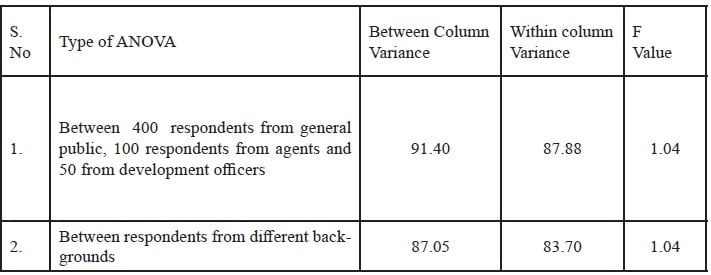
Because of liberalization and other developments, the factors that have been identified through literature review and purified through exploratory factor analysis, must have impact on the insurance sector in general and on LIC in particular. To further explore the impact of these attributes and arena, further articulation of impact measurement dimensions has been carried out.
Assessment of Measurement Properties
The data collected was subjected to multiple statistical analytical methods to assess its measurement properties. Therefore, all the variables were tested for its reliability using coefficient Alpha followed by Exploratory
Factor Analysis and Confirmatory Factor Analysis. Finally, impact measurement was assessed for its construct validity that included content and face validity, convergent validity, discriminant validity and predictive validity.
The following sections discuss each of the above mentioned methods in detail. For all the statistical methods, the statistical software package (SPSS Statistics 20.0) was used.
Assessment of Reliability
Literature indicates that Coefficient Alpha is by far the most meaningful of the various reliability assessment tools; because of that the square root of the alpha is the estimated correlation of the k- item test with errorless true scores pointed out by Nunnally (1967). Typically, a scale is said to be reliable if the alpha value is greater than 0.60 for an exploratory study, with an ex-post facto design of this nature.
Table 5: Coefficient Alpha Values for Reliability Assessment

The overall coefficient alpha for the 8 variables is shown in Table 5 (550 respondents) which is above 0.60 in both the cases. Therefore, the results are on a reliable scale for the construct even with both the samples. Mulaik (1972) has summarized “the major disadvantage of pure exploratory factor analysis (EFA) lies in the difficulty involved in interpreting the factors. The difficulty most often comes about because the researcher lacks even the tentative prior knowledge about the process; that produces co-variation among the variables studied and has no basis on which to
make his interpretation. In these circumstances, the interpretations given the factors may be nothing more than tautological transformations of the names of the original variables”. To overcome the inherent limitations of EFA, confirmatory factor analysis was performed for the study.
Confirmatory Factor Analysis
The eight variables mentioned above were subjected to a confirmatory factor analysis . This yielded 4 statistically distinct factors explaining nearly 44.2 % of the variance. Table 6 summarizes the output of the CFA on the pilot data. As mentioned earlier, the pilot consisted of a sample size of 550 respondents.
Table 6: EFA and CFA (N = 550)
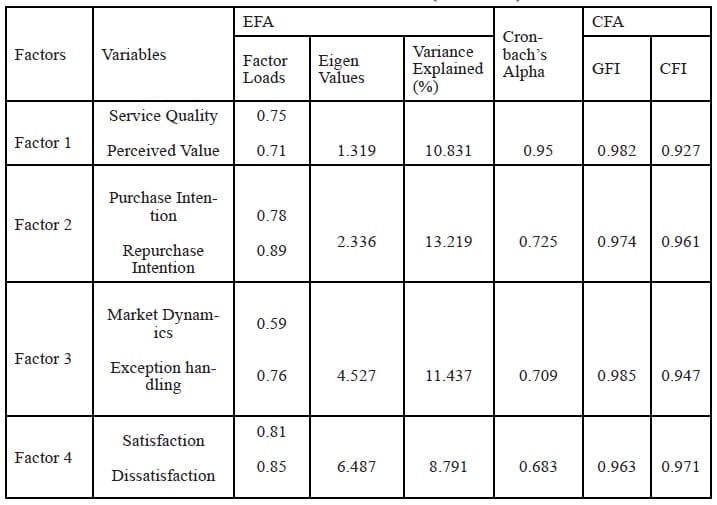
The final stage involved confirmatory factor analysis to determine the number of relevant factors and to evaluate construct validity and their unidimensionality. Therefore, in order to identify relevant factors and to establish the validity of the concept, confirmatory factor analysis was undertaken. As per the nature of this study, there are 8 variables focusing on the 4 underlying factors. Table 6 shows that both the analysis (EFA & CFA) explore the same four underlying factors. Moreover, the table also shows that the goodness of fit index (GFI) and comparative fit index (CFI), which are all above 0.8 levels which indicate that there is uni dimensionality in the factors stated Hart (1994) and Katos (2010). The factor analysis yielded four statistically distinct factors explaining 44% of the variance.
CONCEPTUALIZATION OF IMPACT MEASUREMENT
This section illustrates the impact measurement of liberalization on LIC and narrates how the domain of concept contributes to achieve the objectives of study. The results of literature synthesis convey that, the dimensions to assess impact provided by liberalization can be assessed by reviewing the knowledge of three areas such as, industry oriented aspects, LIC oriented aspects and customer oriented aspects. The results of literature synthesis on the concept came up in the form of 43 variables, which led to develop the domain of impact measurement constructs in terms of eight variables. Therefore, the study has evolved eight focused dimensions to assess impact provided by liberalization, in contrast to 43 variables available in literature. Like any other study, in the present study constructs are developed in terms of specification of specialized boundaries by anchoring three questions related to scope, impact and dimensionality. Therefore, it is concluded that the eight constructs are conceptualized in such a way, that it has scope, ability to generate impact and is composed of relevant dimensions. The study has evolved the domain of constructs in terms of eight reliable dimensions. The developed dimensions in this study are new, even though they are strongly grouped in literature. Therefore, an alpha value of 0.60 was considered as the cut-off value. As can be seen from Table 4 Cronbach’s Alpha values of the dimensions were well above the cut-off value.
Table 7: Articulation of Impact Measurement Variables
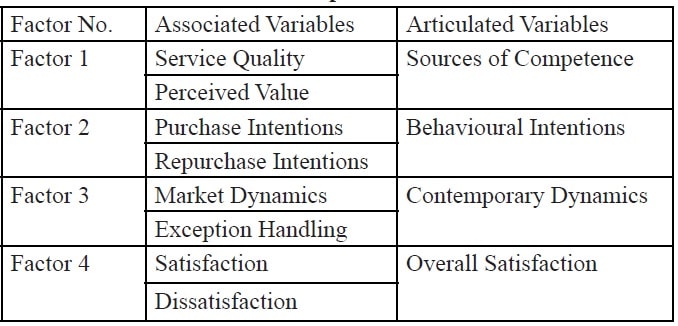
After conducing preliminary statistical tests successfully, the impact of liberalization focuses on four aspects: sources of competence; behavioural Intentions; contemporary dynamics; and overall satisfaction as shown in
Table 7. This study concludes that, liberalization has brought impact into these four aspects, and these are sufficient to measure and represent the overall impact of liberalization on the insurance sector in India.
CONCLUSIONS
Conclusion on the impact of liberalization on the business of LIC India. In the scenario of declining interest rates, the guaranteed products underwent revision and finally had to be phased out. The buoyancy in the stock market led to a gradual shift in customer preference towards unit linked products. Life insurance was looked at as an investment option rather than an instrument to avoid risk. Factors that led to this change were a healthy growth rate of the population, age-mix favorable for life insurance, increased consumerism and higher risk appetite. The surge in demand for credit for home loans and vehicle loans resulted in increased borrowing, leading to higher off take of life insurance cover as collateral.
Conclusion on environmental changes in the life insurance sector with special focus on LIC
This research work is done with the broad objective of analyzing the various emerging trends and prospects of LIC after liberalization. The components of privatization and globalization incorporated within the Indian life insurance industry through the reforms in 2000, absolutely ignited the engine of growth. This research work is an attempt in that direction. The study has undertaken serious efforts to analyze the market to diagnose both supply and demand side bottlenecks, within the constraints set by the availability of desired data. The process of de-monopolization has opened wide vistas in the Indian life insurance scenario with the advent of the private players. The socio-economic configuration of the Indian society and its dynamically changing pattern also offer enormous possibilities for the inflow of FDI.
The research problem of the study is the utilization of the opportunity to review the performance of post-privatization and analyze the expectations of the industry at large; and the extent to which the aspirations and
commitments have been achieved or addressed. The current competitive and dynamic arena in the Indian life insurance industry falls within the scope of work of the Monopolistic Competition, because the number of life insurance firms in India are 25 in number. The total performance assessment of LIC is consistent. With the economic reforms and privatization of the insurance segment, the level of competition has however increased. The service standard of insurance corporations has been enhanced beyond imagination. The impact of these dynamics are seen on LIC as well. Now, LIC has become more cognizant concerning its products. Their performance is unaffected and LIC has preserved the market value of their products and services. Hence, LIC is doing a wonderful
job since the beginning till now, in handling the products and the related marketing strategies successfully. LIC is an old trusted brand; and it has to launch new policy plans that can connect the needs of the customers. At the same time, LIC has to train and grow its employees so that they can serve the customer with full devotion. In short privatization, has favourably affected the LIC of India, which resulted in the overall progress of its operations. The privatization of the insurance sector has brought in a lot of opportunities for all the players. Under such a situation, best of the best will survive and the rest will go out over a period of time.
Conclusion on the attitude of the general public towards the concept of life insurance.
The study reveals that the Life Insurance Corporation of India captured a major role in the insurance business. 95% of the rural people agree that Government Insurance companies have greater impact than private companies.
Only urban and highly educated people have knowledge about private insurance companies. The opinion of the rural & illiterate class have a positive opinion on the traditional Government insurance companies. Almost all the rural sections are familiar with traditional policies and do not agree with private insurance companies. Also they fear private management and their genuineness. The opinion of the urban population is also positive on Government
insurance companies. But majority of them engage with private agencies and innovative policies, which are profitable. They opined that there are plenty of business opportunities in India for both Government and private
agencies. Competition is a must in any form of business. The insurance sector is not an exception to this. Before privatization in this sector, there were only limited policies and business opportunities in the country. With privatization, a tremendous response and penetration is observed. Any innovation will take time to absorb in the economy. But we should not neglect the business opportunities that will develop the economy.
Conclusion on public expectations from life insurance companies.
Earlier to 2000 LIC was not paying serious attention to develop its business. The reason was simple. It was the only Government body who was providing insurance to the public and hence LIC was enjoying its monopoly in the Indian market. Therefore, LIC has created huge surplus also in its annual reports. But somewhere between this monopoly and government guidelines, the need of an individual consumer was significantly unnoticed. The presence of products based on customer need was lagging behind. One has to opt among the existing traditional services and products to cover his other financial risk for the financial safety of his near and dear ones.
Conclusion on functional strategies of LIC.
The privatization of the sector has brought many changes in LIC. Corporate Active Data Warehouse (CADW) is one of the largest life insurance customer databases in the world that LIC has set up to address customer needs, . The project has permitted LIC to launch customer focused campaigns like Customer Contact Program and Global Club Customer Campaigns launched in the various A class cities during the year 2009-2010.
One of the chief accomplishments has been, to send a single notice for the premium falling due in the same month for the various policies of an individual policyholder. All these initiatives launched have made the brand of LIC more visible in the eyes of the policyholders and public in general LIC has implemented the Enterprise Document Management System (EDMS) in its offices to digitize the customers and office records. EDMS has been done to get the advantage in terms of enabling the concept of anywhere anytime service through electronic files, to make documents and files available to multiple users simultaneously. This will also eliminate the need to transfer paper records from one branch to another branch. Premium can be paid through various banks like City Bank, HDFC Bank, ICICI Bank, Federal Bank, Corporation Bank, Axis Bank and other service providers like Bill Desk and Tech Process which cover almost all other banks throughout the country. Premium can be paid through credit
cards also. Premium payments can also be made through ATM cards and electronic bill presentation and payment. Premium can be deposited for the in force policies only which are not linked with monthly or salary saving schemes. IT enabled support systems have been set up to reduce manual intervention and to minimize grievances. LIC has grievance redressal officers at their branch, divisional,/zonaland cntral offices to redress the grievances of policyholders and for bringing transparency in the operations. For quick redressal of grievances, LIC has introduced a customer friendly complaint management system, through a customer portal, where the policyholder can straightly register any complaint and track its position anytime on their own.
Contribution and Implementation of Research Findings
The results of this study have a number of significant implications. First, it is one of the few studies which attempt to investigate the empirical relationship between impact measurement and its four factors i.e. sources of competence, behavioural intentions, contemporary dynamics and overall satisfaction. The present study provides useful and comprehensiveness knowledge about pre and post situation of insurance sector in context to liberalization specifically focusing on LIC. The integration of these four constructs with impact measurement will help researchers and practitioners, to further grasp factors influencing the assessment of impact analysis in the industry. The results demonstrate a considerable explanatory and predictive power. Thus, the integration of the sources of competence, behavioural intentions, contemporary dynamics and overall satisfaction factors with impact measurement; is both theoretically appealing as well empirically significant.
REFERENCES
Anderson, E.W. and Sullivan, M. (1993) The Antecedents and Consequences of Customer Satisfaction for Firms, Marketing Science, 12, pp.125-43.
Barros, P. P. (1996) Competition Effects of Price Liberalization in Insurance. The Journal of Industrial Economics, pp.267-287.
Baumann, C., Burton, S., Elliot, G. and Kehr, H.M. (2007) Prediction of Attitude and Behavioral Intentions in Retail Banking, The International Journal of Bank Marketing, 25:2, pp.102.
Bearden, W.O. and Mason, B. (1984) An Investigation of Influences on Consumer Complaint Reports, Advances in Consumer Research, 11:3, pp.490-495.
Chakraborty, J., and Sengupta, P.P. (2016) Indian Life Insurance Market and Corporate Performances: A Study Of Selected Firms, International Journal of Banking, Risk and Insurance, 4:1, pp. 26.
Chaudhury, K. (2013) Service Quality and Customers’ Purchase Intentions: An Empirical Study of the Indian Banking Sector, International Journal of Bank Marketing, 31:7, pp.529-543.
Colgate, M. and Hedge, R. (2001) An Investigation Into the Switching Process in Retail Banking Services, International Journal of Bank Marketing, 19:5, pp.201-212.
Cornwell, T.B., Bligh, A.D. and Babakus, E. (1991) Complaint Behaviour of Mexican-American Consumers to a Third-Party Agency, Journal of Consumer Affairs, 25:1, pp.1-18.
Cronin, J.J. Jr, Brady, M.K., Brand, R.R., Hightower, R. and Shemwell, D.J. (1997) A Cross-Sectional Test of The Effect and Conceptualization of Service Value, Journal of Services Marketing, 14:6, pp. 375-91.
Cronin, J.J., Brady, M.K. and Hult, G.T.M. (2000) Assessing the Effects of Quality, Value, and Customer Satisfaction on Consumer Behavioral Intentions in Service Environments, Journal of Retailing, 76:2, pp. 193-218.
Croson, D.C and Lorin M. H., (2004) Tracking a Transformation: E-Commerce and the Terms of Competition in Industries, Brookings Institution Press, Washington D.C.
Das, D., and Debnath, J. (2012) Performance of Insurance Companies in India: A Comparison of Public and Private Insurers, IUP Journal of Risk and Insurance, 9:1, pp.7.
Devasenathipathi, T., Saleendran, P.T., and Shanmugasundaram, A. (2007) A Study on Consumer Preference and Comparative Analysis of All Life Insurance Companies. ICFAI Journal of Consumer Behavior, 2:4.
Dhar, S.K. and Dhar, U. (2007) Insurance Industry in India- An insight, 3, pp. 17-25. Dodds, J.C., (1979) The investment behaviour of British life insurance companies. Routledge, Keegan and Paul.
Durvasula, S., Lysonski, S., Mehta, S.C. and Tang, B.P. (2004) Forging Relationships With Services: the Antecedents That Have an Impact on Behavioural Outcomes in The Life Insurance Industry, Journal of Financial Services Marketing, 8:4, pp.314-26.
Dutta, K. (2009) Consumer Beiefs and Attitudes Towards Advertising Media: A Study of Indian Women, Indian Journal of Marketing, 39:12, pp.23-28.
East, R. (1997) Consumer Behaviour: Advances and Applications in Marketing, Prentice-Hall Europe, London.
Fishbein, M., and Ajzen, I. (1977) Belief, Attitude, Intention, And Behavior: an Introduction to Theory And Research, Reading M.A.: Addision Wessley.
Fornell, C. (1992) A National Customer Satisfaction Barometer: The Swedish Experience, The Journal of Marketing, 6-21.
Garg, M and Deepti. (2008) Efficiency of General Insurance Industry in India in the Post-Liberalization Era: A Data Envelopment Approach, The IUP Journal of Risk & Insurance. p.18.
Garg, M. (2008) Efficiency of the General Insurance Industry in India in The Post-Liberalization Era: a Data Envelopment Approach, Icfai Journal of Risk and Insurance, 5:1, 32-49.
Garg, M. C., and Verma, A. (2010) An Empirical Analysis of Marketing Mix in the Life Insurance Industry in India, IUP Journal of Management Research, 9:2, pp. 7.
Gidhagen, M. (1998) Insurance Marketing – Services and Relationships. Working Paper, Department of Business Studies, Uppsala University.
Gupta, N. (2001) Responsible Reassurance, A & M September, 27-33.
Gupta, P., and Byana, S., (2002) Insurance Sector, Challenges and Strategies. JIMS 8M Oct-Dec, p.40-44.
Hellier, P.K., Geursen, G.M., Carr, R.A., and Rickard, J.A. (2003) Customer Repurchase Intention: A General Structural Equation Model, European Journal of Marketing, 37:11/12, 1762-1800.
Hendel, I. and Lizzeri, A., (2003) The role of commitment in dynamic contracts: Evidence from life insurance. The Quarterly Journal of Economics, 118:1, pp.299-328.
Heung, V. C., and Lam, T. (2003) Customer Complaint Behaviour towards Hotel Restaurant Services, International Journal of Contemporary Hospitality Management, 15:5, pp.283-289.
Hofstede, G. (1995) Insurance As a Product of National Values, The Geneva Papers on Risk and Insurance Issues and Practice, 20:4, pp. 423-429.
Huebner, S.S., Black, K. and Cline, R.S., (1982) Property and liability insurance. Prentice Hall.
James, P.C. (2008) Planning for the Risk Economy Role of the Individual, ICFAI Journal of Insurance Law, 6, pp. 10-17.
Jones, T., and Taylor, S.F. (2007) The Conceptual Domain of Service Loyalty: How Many Dimensions?, Journal of Services Marketing, 21:1, pp. 36-51.
Kaur, M., and Kaur, D. (2014) Customer Satisfaction Towards Life Insurance in Punjab, IUP Journal of Management Research, 13:4, pp. 27.
Kim, C., Kim, S., Im, S., and Shin, C. (2003) The Effect of Attitude and Perception on Consumer Complaint Intentions, Journal of Consumer Marketing, 20:4, pp.352-371.
Kumar, P. S. (2015) Role of Indian Public Sector Health Insurers: An Overview, International Journal of Multidisciplinary Approach and Studies, 2:1.
Kumar, S.S., and Ramamoorthy, R. (2014) Health Insurance Market in India–The Way Forward. Health and Medical Care Services: Claims on National Resources, pp.178.
Kumar, S., (2016) The Post-Economic Reforms Possibility of Corporate Social Responsibility in India. Journal of Institute of Public Enterprise, pp.155-172.
Lenskold, J. (2003) Retention Marketing Profitability: ROI Challenges Influencing the Retention Versus Acquisition Debate, Marketing Profitability White Paper Series. Manasquan, New Jersey: Lenskold Group Inc.
Lombardi, L.J. (2005) The Importance of Client Retention, LIMRA’s Market Facts Quarterly, 24:2, pp.31-32.
Marks, S. Dorfman, (1982) Introduction to Insurance, Prentice Hall, Insurance, N.J. Second Edition.
Maysami, R.C., and Sakellariou, C. (2008) Financial Liberalization, Deposit Insurance and Bank Stability, Applied Economics Letters, 15:10, pp. 743-747.
Mende, M., Thompson, S.A. & Coenen, C. (2015) It’s All Relative: How Customer-Perceived Competitive Advantage Influences Referral Intentions, Marketing Letters, 26:4, pp. 661-678.
Michel, S. (2001) Analyzing Service Failures And Recoveries: A Process Approach, International Journal of Service Industry Management, 12:1, pp. 20-33.
Mishra, K. C., and Mishra, S. (2000) The Game Is Changing (4) Global Insurance Market Mittal, V., Kumar, P., and Tsiros, M. (1999) Attribute-Level Performance, Satisfaction, and Behavioral Intentions Over Time: A Consumption-System Approach, The Journal of Marketing, pp. 88-101.
Monroe, K.B. (1990) Pricing: Making Profitable Decisions, 2nd ed., McGraw-Hill Book Company, New York, NY.
Mozaffarian, N., Lobosco, S., Lu, P., Roughley, A. and Alperovich, G., (2015) Satisfaction with control of systemic lupus erythematosus and lupus nephritis: physician and patient perspectives. Patient preference and adherence, 10, p.2051. Mulaik, S.A. (1972) A Mathematical Investigation of Some Multidimensional Rasch Models for Psychological Tests, In annual meeting of the Psychometric Society, Princeton, NJ.
Murthy, T. N., Babu, P. R., and Ansari, R. (2009) Performance Evaluation of LIC: Ways of Winning Confidence, IUP Journal of Risk and Insurance, 6:2, 53. Narayanan, S., (2008) Employment guarantee, women’s work and childcare. Economic and Political Weekly, pp.10-13.
Narayanan. B.S. (2008) Fundamentals of Unit linked pension plan (ULPP) and on how it works. Insurance – Chronicle. pp.47.
Pamecha, S. and Chhajer, A. (2013) Ongoing Journey of Life Insurance: Present Scenario & Future Prospects. Economic Challenges, 15:59, pp.54 – 62.
Pillai, V.N.S. (2007) Simple Approach to Life Insurance and Pension, ICFAI Journal of Insurance Law, 6:2.
R. Ramamoorthy, S.A. Senthil kumar (2014) Product liability insurance: An Indian perspective, The Journal of Insurance Institute of India, 1:3, pp.62 -68.
Rahman, M.S., Mohamad, O., Abdel Fattah, F.A. and Aziz, N., (2014) Factor determining customers’ repurchase intention of healthcare insurance products in Malaysia,: Australian Academy of Business and Social Sciences Conference 2014.
Rajan, A.K., and Dhunna, M. (2002) Liberalization of the Insurance Sector: Social Implications, Indian Management Studies Journal, 6:1, pp.109-118.
Rajendran, R. and Natarajan, B., (2009) The impact of LPG on life insurance corporation of India, Asia Pacific Journal of Finance and Banking Research, 3:3, pp.41-52.
Ramamoorthy, R., Gunasekaran, A., Roy, M., Rai, B. K., and Senthilkumar, S. A. (2016) Service Quality and Its Impact on Customers Behavioural Intentions and Satisfaction: An Empirical Study of the Indian Life Insurance Sector, Total Quality Management and Business Excellence, 1-14.
Salai, S., and Žnideršić, R.K. (2011) Marketing Research in the Contemporary Consumer Environment, Management information systems, 6:4, pp.15-22.
Saxena, R. (1986), Marketing of Life Insurance Services, Yogakshema Dec. Shahriar Ferdous, A. and Jay Polonsky, M. (2013) Predicting Bangladeshi financial salespeople’s ethical intentions and behaviour using the theory of planned behaviour. Asia Pacific Journal of Marketing and Logistics, 25:4, pp.655-673.
Singh, J., and Widing, R.E. (1991) What Occurs Once Consumers Complain? A Theoretical Model for Understanding Satisfaction/Dissatisfaction Outcomes of Complaint Responses, European Journal of Marketing, 25:5, pp.30-46.
Singh, M., and Kumar, R. (2011) Efficiency Analysis of the Public Sector General Insurance Companies: A Comparative Study of Pre-And Post-Reform Period, IUP Journal of Risk and Insurance, 8:4, pp.28.
Singh, S. (2008) Potential for Life Insurance Companies in Indian Suburban Areas: A Special Case of Suburban Areas In Faridabad District, The Icfai University Journal of Risk and Insurance, 5:4, 2008.
Sinha, R. P. (2015) A Dynamic DEA Model for Indian Life Insurance Companies, Global Business Review, 16:2, pp.258-269.
Sogunro, A. B., and Abiola, B. (2014) Measuring Customer Satisfaction on Life Insurance Products (Case Study: Lagos State, Nigeria), International Journal of Management and Business Research, 4:2, , pp.73-80.
Souiden, N. and Jabeur, Y., (2015) The impact of Islamic beliefs on consumers’ attitudes and purchase intentions of life insurance, International Journal of Bank Marketing, 33:4, pp.423-441.
Nunnally, J.C. (1978) Psychometric Theory, 2nd ed., McGraw-Hill, New York, NY. Souiden, N., and Jabeur, Y. (2015) The Impact Of Islamic Beliefs On Consumers Attitudes and Purchase Intentions Of Life Insurance, International Journal of Bank Marketing, 33:4, pp.423-441.
Srinivasan, V., Prakash, P. and Sitharamu, S., (2015) Selection of life agents: A challenge for the Indian insurance industry.
Stewart, K. (1998) An Exploration of Customer Exit in Retail Banking, International Journal of Bank Marketing, 16:1, pp.6-14. Structure, Management Accountant-Calcutta 35:1, pp.51-54.
Sweeney, J.C. and Soutar, G. (2001) Consumer Perceived Value: The Development of Multiple Item Scale, Journal of Retailing, 77:2, pp.203-20.
Tax, S.S., Brown, S.W., and Chandrashekaran, M. (1998) Customer Evaluations of Service Complaint Experiences: Implications for Relationship Marketing, The Journal of Marketing, pp.60-76.
Tone, K., and Tsutsui, M. (2010) Dynamic DEA: A Slacks-Based Measure Approach. Omega, 38:3, pp.145-156.
Tsoukatos, E. and Rand, G.K. (2006) Path Analysis of Perceived Service Quality, Satisfaction and Loyalty In Greek Insurance, Managing Service Quality, 16:5, pp.501-19.
Ushakiran, V., Goud, M.M., and Murthy, S.S. (2013) Impact of Privatization on Risk Business: A Study of the Life Insurance Sector in India, The Journal of Venture Capital and Financial Services, 7:1/2, pp.32.
Vaidyanathan, R. (2007) Declining Joint Family and Emerging Crisis in Old Age Security, International Journal of Indian Culture and Business Management, 1:1-2, pp.151-173.
Volkov, M., Harker, D. and Harker, M. (2002) Complaint Behaviour: A Stuffy of the Differences between Complainants about Advertising in Australia and the Population at Large, Journal of Consumer Marketing, 19:4, pp.319-32.
Warland, R.H., Herrmann, R.O. and Willits, J. (1975) Dissatisfied Consumers Who Gets Upset and Who Takes Action, Journal of Consumer Affairs, 6, pp.148-63.
Westbrook, R.A. (1987) Product Consumption Based Affective Responses and Post-Purchase Processes, Journal of Marketing Research, 24, pp.258-70.
Zameer, H., Tara, A., Kausar, U., and Mohsin, A. (2015) Impact of Service Quality, Corporate Image and Customer Satisfaction Towards Customers’ Perceived Value In The Banking Sector In Pakistan, International Journal of Bank Marketing, 33:4, pp.442-456.
Zeithaml, V.A. (1988) Consumer Perceptions of Price, Quality and Value: A Means-End Model and Synthesis of Evidence, Journal of Marketing, 52:3, pp.2-22.
Zeithaml, V.L., Berry, L.L. and Parasuraman, A. (1996) The Behavioral Consequences of Service Quality, Journal of Marketing, 60, pp.31-46.
Dr. Nimit Gupta, Associate Professor, Fortune Institute of International Business, Delhi. Email: nimitgupta1981@rediffmail.com.
Dr. Sudhir Rana, Assistant Professor, Fortune Institute of International Business, Delhi
Mr. Arpan Anand, Assistant Professor, Fortune Institute of International
Business, Delhi and Research Scholar, Punjab University, Chandigarh.



